
THE JATROPHA SYSTEM
AS A MOTOR OF SUSTAINABLE RURAL DEVELOPMENT
TOGOLESE PROVERB (of the Ewe People): Wometsoa deve si le amesi la noa xa wom o = You do not turn your oil palm grove into a broom industry. In other words: Know the real value of your resources and do not waste them. Judge the worth of your resources rightly.
CONTENTS
- Introduction – why no large scale plantations
- What exactly is Jatropha
- Traditional and modern use of the whole plant
- A promising future for Jatropha and other Bio-Fuel Business & Politics
- Sustainability demystified
- Sustainability of the Jatropha System - seen from a social-economic angle
- Essential characteristics of the Jatropha System
- Hybrid variations of the Jatropha System
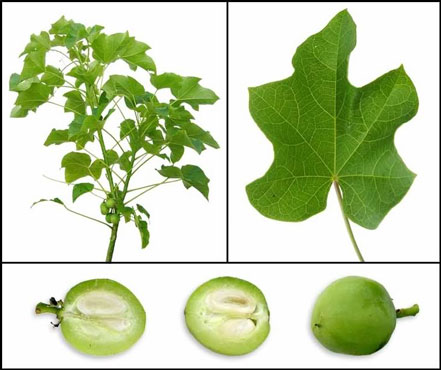 |
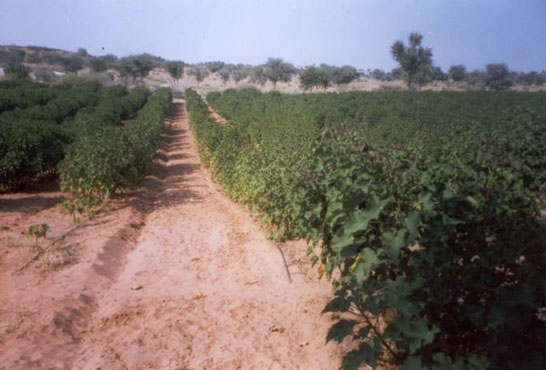 |
|
Jatropha branch, leaf, fruit / Seeds contain about 39% oil |
Large scale Jatropha Plantation in India |
|
Introduction – why no large scale plantations
Before summarizing the essential characteristics of the Jatropha System itself, we will explain why the Togolese <FOOD & BIO-ENERGY PROJECT> (TOMOKA) initiated by the GuKam Company, has decided to refrain from large scale Jatropha plantations. GuKam is convinced that large Jatropha plantations are not viable and not desirable in extremely poor and relatively small countries like Togo. Not viable because the brain drain of the last 20 years left us with insufficient managerial competences and technical skills for such huge enterprises. Moreover, Togolese entrepreneurs do not possess sufficient capital, and our rural roads and other infra structures are by far below the minimum levels required for bulk transportation of crops to large oil mills, and for the export of the bio-fuel itself. Another constraint is the fact that the State does not own the required large quantities of arable land to <give away, sell or rent out> to foreign companies. Then the State also lacks the capital to start and manage such complex programs.
Large scale Jatropha monocultures are not desirable either. Dependency on one source of income is risky when there are no other sources of income. Moreover, mono culture absorbs a lot of land and may endanger the national food security and biodiversity in developing nations. Large scale Jatropha plantations do not contribute much to the economic development of the poor population of such countries either. Until this moment there is not one single developing country where such large foreign enterprises have considerably and sustainably improved the livelihoods of the poor . Uplifting our extremely poor rural populations is what Togo needs most! Our own business climate will improve considerably when the population has more disposable income. And that is precisely what is going to happen when we opt for a small-scale development method like the Jatropha System.
The following paragraphs elucidate the relevance and workings of the Jatropha System which is an integrated and sustainable development method. It enables medium size and small companies like GuKam to make attractive profits while introducing Jatropha cultivation and processing in rural areas where the populations are stimulated to participate intensively in all aspects of this new economic endeavour.
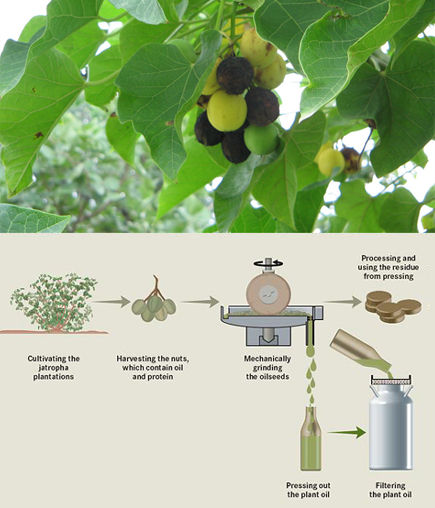 |
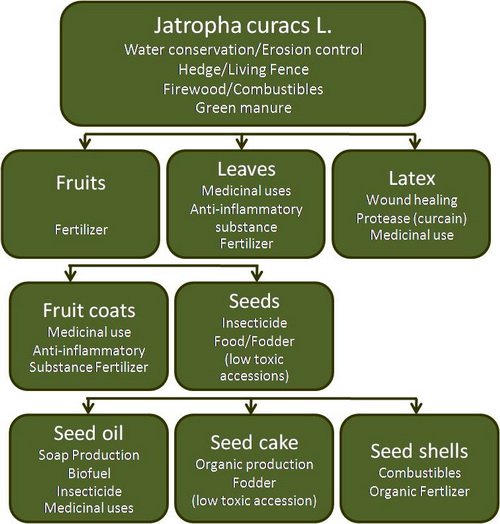 |
|
From seed to pure plant oil (PPO) – a simple process |
All parts of the Jatropha plant are useful |
|
We, at the TOMOKA Project will first deal with the characteristics of the <Jatropha curcas> plant. And then we will highlight its economic functions by mentioning its manifold traditional and modern uses. It will also become clear that the new worldwide bio-fuel industry sees Jatropha only as a feedstock for bio carburant production while all other functions are ignored. Meanwhile these other uses and functions of Jatropha are decisive for a poor country like ours which aims at sustainable social and economic development. Our paragraphs on sustainability issues and Development Goals will make it clear that the Jatropha System does effectively contribute to this objective. Indeed, small-scale and medium size Jatropha plantations, and agro-industries are appropriate and effective! And this will be even more the case when we combine the Jatropha System with Increased Staple Food production and processing.
What exactly is Jatropha curcas L.
Jatropha curcas or Physic nut (in French: Pourghère) is a tall bush or an over 6 meter high small tree. It belongs to the Euphorbiaceae family. It used to be a wild, uncultivated non-food species. It originates from Mexico and Central America, but has spread all over the tropical world. It is found abundantly in many tropical and sub-tropical regions throughout South America, Africa and Asia. And it is spreading rapidly because commercial projects abound in the form of small-scale and large scale Jatropha Plantations in countries like Brazil, India, Mali, Tanzania, Senegal, Ghana, Mozambique, China and many, many more.
Jatropha is a perennial plant with a life cycle of 40 to 50 years, which means that farmers will not have to replant it every season which saves both money and time. The plant is easy to propagate, grows relatively quickly and is drought resistant. Good crops of 2 to 4 kilos of seeds per plant, per season can be obtained with little effort, although traditional harvesting is labour intensive. Once the tree reaches maturity (up to some point, after the 3rd or 4th year), yields will stay stable.
Due to the toxicity of its leaves, Jatropha is not browsed. It was therefore traditionally used as living fences (hedges) around gardens, fields and houses t against roaming cattle and wild animals. Moreover, these hedges are often used to prevent water erosion. Jatropha can grow well in marginal/poor soils with 600 mm rainfall or more per year. That makes it an attractive produce for development planning in arid areas.
Jatropha should not be planted close to cassava, since it plays host to viruses that may attack this staple food, and vice versa. Most likely, there are similar negative effects in relation to millet (Senegal) and cashew nut trees (Mozambique).
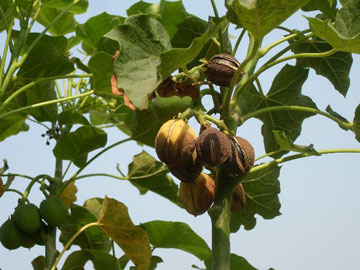 |
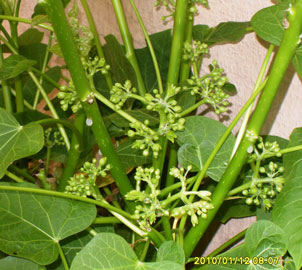 |
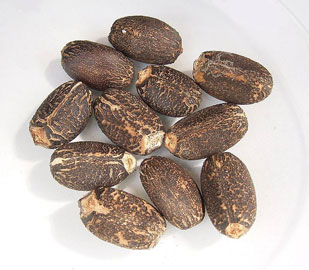 |
||
Jatropha Fruits ready for harvesting on TOMOKA’s Mini Pilot. Harvesting is possible at an even earlier stage when the fruits are yellow |
Blooming Jatropha in TOMOKA’s Demonstration Nursery behind the Project office, in Lomé – Plant age: 4 weeks -- Propagation material: cuttings |
Each Jatropha fruit contains two seeds like these |
||
Traditional and modern use of the whole plant
Once mature, Jatropha plants keep producing seeds. Seed Yields vary widely which is to be expected because Jatropha can grow under many different conditions. Hedges in Mali appear to produce 0.8 to 1.0 kg per metre. The FACT Foundation presents an overview of seed yieldin different parts of the world. Low production figures mostly apply to young plantations of 1-2 years old. Dry weight of seeds from mature plants appears to range from a couple of hundreds of kilos to 4.1 tons per hectare. But some reports on the internet even mention 6 or 9 tons – figures which may be based on expectations, not on realized crops.
The average dry seed weight is about 750 grams per 1000 seeds; equivalent to about 1333 seeds per kilo. Depending on soil quality, rainfall, temperatures and agricultural inputs, oil can be extracted from the seeds after two to five years. The reported oil content varies between 30 to 39% of the seed weight. It is a highly suitable source of energy for cooking and lighting by itself, and can be used as bio fuel for many types of diesel engines. It is easily turned into modern biodiesel for which there is a high and increasing world-wide demand. Oil production per hectare appears to be 1.5 tons or more. Traditionally, the oil is widely used for soap making in Africa and in countries like Portugal until the 1960s . Recently, several varieties of household and luxury soaps are being produced – in particular for higher segments in Western consumer markets.
All parts of the plant were traditionally used for medical and veterinary purposes. This is still the case in many African countries. The oil has a strong purgative effect and is used to treat skin diseases and to soothe pain from rheumatism. The sap flowing from the stem is used to control the bleeding of wounds. Research into chemical and physical characteristics of Jatropha oil shows that Jatropha oil is able to play a major role in the bio-fuel needs of industrialised countries: it can easily produce biodiesel which meets the restricted specifications of the European Union (EU 14214). The viability of Jatropha oil as a jet fuel has also been demonstrated. The Aviation Fuel market is capable of absorbing large quantities. Moreover, Jatropha oil fits well within the specifications requirements of main producers of endothermic engines for electricity and heat generation. The rural electrification program in Mali, for example, uses Jatropha oil as its sole carburant. Those machines are able to run on Jatropha’s pure plant oil. The same is true for most of Togo’s older (pre-combustion chamber) diesel engines in trucks. Modern diesel engines need a small adaptation before they can run on this locally produced fuel. And, finally, the oil can be used as a lubricant.
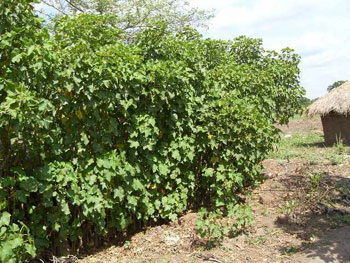 |
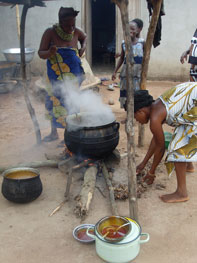 |
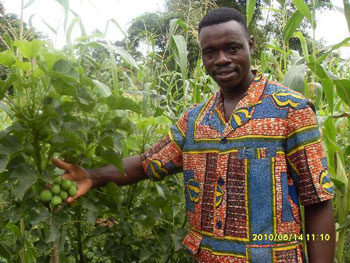 |
||
Traditional Jatropha Hedge near the TOMOKA Project |
The ambition is NOT to use any wood for cooking |
Modern Intercropping of Jatropha & Maize demonstrated by GuKam on the Project’s Mini Pilot in Danyi . The Jatropha plant is 14 months old |
||
It is widely claimed that Jatropha enriches the soil. And indeed, the seed cake (residue of oil extraction ) is used as effective manure. Moreover, it can be used for the production of biogas. The anti-insect properties which are claimed as well need to be investigated into more details. And the same can be said about its resistance to all kinds of pests and viruses, and its protective and stimulating influence on the growth and harvests of nearby (intercropped) staple crops like maize, onions, peppers, groundnuts and beans.
A promising future for Jatropha and other Bio-Fuel Business & Politics
The use of vegetable oil instead of fossil oil has many advantages. Fossil oils become scarce and prices are rising all the time. Consequently, there is an increasing demand for renewable energy. Moreover, the use of fossil oils is a major cause of world-wide climate changes. Bio-fuels do not have this devastating effect. They have an almost closed carbon dioxide cycle, because the CO2 emitted during Plant Oil production and its combustion is captured by the plant during its growth. This helps to stop the global CO2 concentration rise in the atmosphere.
The demand for bio-fuel is growing every day. The daily Biofuels Digest Newsletter shows that major Industries, Investors and Multi National Oil Companies are increasingly active in the field of Jatropha. Thousands of initiatives for the cultivation of Jatropha have been started up by them and by farmer cooperatives, entrepreneurs, NGOs, Governments and small and large companies all over the world. Specialised Consulting Firms assist them with analysing and implementing innovative and sustainable bio-fuel production chains based on Jatropha. And Governments of several developing countries have made this a National Development Priority. They include India, Mali, Brazil, Ghana, Tanzania and Senegal.
Africa seems central to the worldwide growth of initiatives in Jatropha based bio-fuel. American, Dutch, British, German, Swedish, Canadian, and Japanese firms are competing for farmland to grow non-food energy producing crops like Jatropha. Ghana has made itself a vocal point of large-scale bio-fuel growth when farmers questioned the viability of large scale cultivation of Jatropha. They not only witnessed displacement of small farmers, but became also concerned about what this large scale approach means for food security in their country. Negative side effects like these will be avoided when the people oriented small scale production method of the Jatropha System is implemented after having been adapted to local circumstances, while using land which has not yet been used for agricultural purposes.
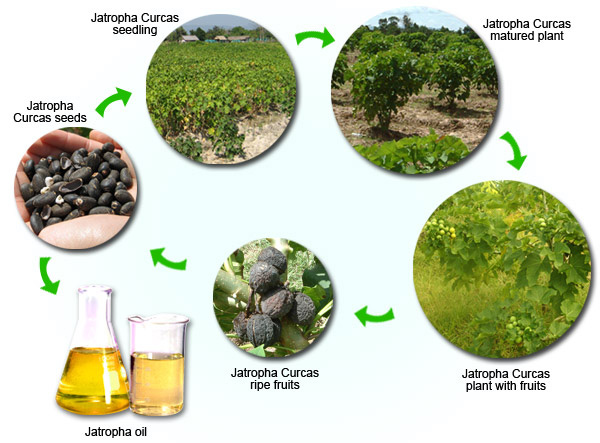 |
|
The TOMOKA Project introduces this complete Jatropha production cycle in Togo -- from seed to oil |
Sustainability demystified
Large-scale Jatropha Plantations and even small mono culture plantations do not necessarily contribute to conservation of the environment or to rural development of the indigenous population. That is why the internet Platform JatrophaBook has been set up to assist smallholders, and to provide them access to the Jatropha market. The platform explains that <within JatrophaBook, it will be possible to share knowledge from on-field practices, share scientific know-how (..) and to start specific discussions related to sustainable practices.>
Sustainability is a complex concept. But it is not as mysterious or vague as the literature often suggests. It not only means that we want to maintain, and keep something in existence. It also implies that we supply all that is needed to support the vitality of that something. In the case of rural development this means that we want to start up a continuous process by which the members of our extremely poor rural population expand and realize their potential within their own rural setting. As is demonstrated with our <FOOD & BIO-ENERGY> Project, the introduction of the Jatropha System will trigger off his continuous development process! Our TOMOKA Project has even given it more impetus by combining it with Increased Staple Food Production. Our <Food & Bio-fuel Energy> cocktail will prove to be a powerful vehicle for rural development, because it establishes a durable upward development spiral within the rural community itself -- in ecological, social, energy, and economic terms. This website is not the place to elaborate these four interacting aspects into further detail. Some words from the social angle will illustrate what we mean with this kind of interactions.
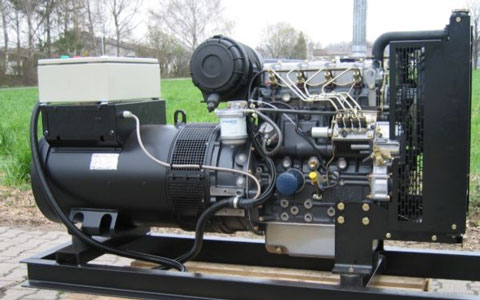 |
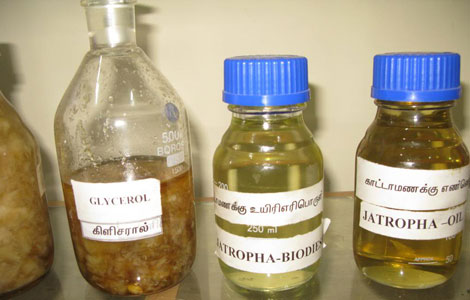 |
|
Jatropha Oil used by a Perkins Engine with generator |
Jatropha Oil and its Main Derivates |
|
Sustainability of the Jatropha System - seen from a social-economic angle
The Social aspect of sustainability will take many forms and effects in projects like ours which adopt a hybrid form of the Jatropha System. The combined cultivation of Jatropha with other produce like maize and beans makes the farmers less dependent on price fluctuations. And most importantly: poor farmers will earn much higher incomes than before. This Hybrid form of the Jatropha System sets up a series of production factors which are directed towards a durable improvement of the typical farmer’s living conditions.
Contrary to many other forms of agriculture, the farmers who participate in the Hybrid Form of the Jatropha System will contribute positively to the environment: cutting of trees for traditional energy (charcoal making) will stop. The soil will not degrade anymore, because the oil extraction residues (seed cake and sediments) will go back to it and restore its fertility. Moreover, the new Jatropha trees will be growing on unused land that has suffered from deforestation. Replanting those areas with profitable Jatropha plants (and in our TOMOKA Project: also with food crops and useful trees) will contribute to a rehabilitation of the natural environment and CO2 sequestration.
The rural population will acquire new modern skills and knowledge which will revitalize our agricultural sector. There will be hundreds of new jobs and incomes on at least 100 new small-scale farms, on Gukam’s midsize Food & Bio-Energy Plantation and in the new agro-industries which will process the surplus food crops and Jatropha harvests. Moreover, 300 existing farms will be encouraged to plant Jatropha Hedges around their properties, enabling them to raise their annual incomes significantly. All this will slow down or even stop the migration to the big cities and the diaspora. Moreover, the increased economic activity will lead automatically to higher incomes for the local and national authorities via fair taxation. And their enlarged budgets will lead to considerable improvements of infrastructures (like roads and potable water), health care and education.
By shifting from unhealthy traditional energy sources (smoky charcoal and expensive fossil oil) for cooking and light, to locally produced environment friendly bio-carburant (Jatropha oil), we contribute to environmental preservation and better health -- especially the health of our women who do the cooking. Rural electrification will trigger off many cultural, educational and economic activities which will speed up the organizational and other developmental processed referred to already.
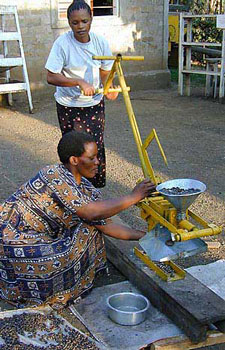 |
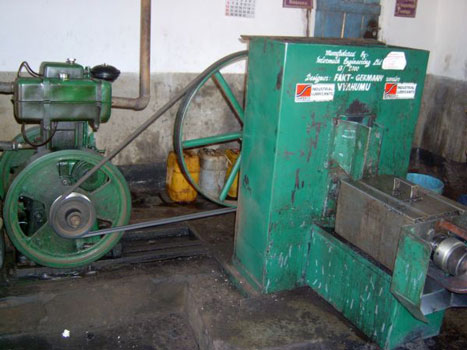 |
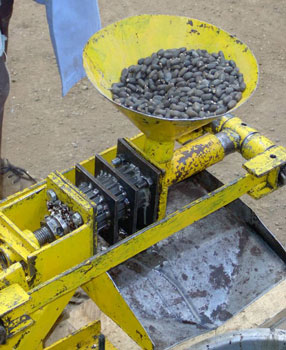 |
||
Hand Press introduced at an early stage of the classic Jatropha System (here in Tanzania) |
The Sayari Expeller (produced in Tanzania) is commercially viable and will be introduced by TOMOKA in the Canton of Dawlotu Tutu. It runs on Jatropha Pure Plant Oil while crushing Jatropha Seeds. |
Detail of the Hand Press used for demonstrations and very small oil production (Bieleberg Ram Press) |
||
And there is even more to it: by making the rural population aware of the great value of the things at their own disposal, we empower them in the real sense of the word. We help them to become more self-sufficient and self-reliant! Their land, food staple crops, Jatropha harvests, and their traditional organizations, skills and knowledge about crops and cooperation prove to be valuable and capable of absorbing innovations. They will become confident that it is possible to improve the quality of life themselves.
Subsequently, our nation is becoming less dependent on foreign imports and aid, and it will have larger budgets at its disposal for infrastructural improvements and for the other development priorities to which it has subscribed in the context of the UN Millennium Development Goals. Togo will increasingly support its functioning from below, from the people who form our nation. Indeed, TOMOKA’s hybrid form of the Jatropha System will significantly contribute to our country’s sustainability!
Essential characteristics of the Jatropha System
The internet abounds with publications about the Jatropha System. It was more or less a “lucky outcome” of attempts to encourage the use of plant oil as a bio-fuel. Germany’s major Institution for Development Cooperation – the ‘Deutsche Gesellschaft für Technische Zusammenarbeit (GTZ)’ – and the French ‘Centre National de l’Énergie Solaire et des Énergies renouvelables (CNESOLER)’ started a pilot study in Mali in 1993. In an Evaluation Study on Jatropha curcas in Africa (2009) by one of the System’s pioneers, Dr Reinhard K Henning, it is stated that the aim of the project was “to verify the technical, financial and economical feasibility of an integrated approach with Jatropha trees and – if successful – disseminate the approach on a larger scale. The report concludes that the economic viability of the Jatropha System, on meso and macro level, is very satisfactory. Consequently, its dissemination took off in high speed, and the approach has become one of Mali’s national development priorities.
The central hypothesis of the Jatropha System is stated on the cover of what many users call the ”pioneering, classic handbook for Jatropha cultivation”: The Jatropha System – An Integrated Approach of Rural Development in Tropical & Subtropical Countries (update 2009). It states that “the Jatropha System creates a positive reciprocity between raw material / energy production and environment/ food production”. And the System’s main objectives in Mali appear to be 1)Erosion control, 2)Women promotion (empowerment), 3)Rural income generation, and 4)Renewable energy production. They fit in very well into several UN Millennium Development Goals (MDG). The Jatropha System contributes significantly to MDG 1, 3 and 7. Respectively, these intend to 1) Eradicate Extreme Poverty and Hunger, 3) Promote Gender Equality and Empower Women, and 7) Ensure Environmental Sustainability.
 |
 |
 |
 |
 |
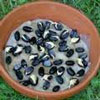 |
 |
 |
|||||||
Uses of Jatropha oil on village level in the classic form of the Jatropha system |
||||||||||||||
The evaluation study mentioned before lists (on page 37) the essential characteristics of this <classic> Jatropha System as it has been developed in arid rural areas in Mali. It is typified as a rather complex system with various agro-ecological, social, financial, meso- and macro-economic effects. Its major components can be discerned in its definition. The integrated approach implies “planting the trees in the form of hedges, organizing on village level the harvest and pre-processing stages of the seeds, gaining the Jatropha oil and all by-products in a small-scale hand-operated or motor-driven oil mill, and finally studying and influencing market conditions in a way that the sale and use of all these products becomes financially viable for all target groups concerned.”
TOMOKA adds that the “by-products” not only included the press residues (seed cake, and sediment of oil purification), but also the final products from small agro-industrial activities like soap making, and – at a later stage – rural electrification. In other words: agriculture, agro-industry and local consumption form one unified system of elements in which the added surplus value (via agro-industry and sales) stays within the rural community itself. This makes it a powerful motor of all kinds of rural development processes.
Hybrid variations of the Jatropha System
Since its conception, the Jatropha System has been introduced into countries like Tanzania, Madagascar and Mozambique. The system’s classic profile depicted above, has undergone an evolution since then. During the last 10 years it gradually changed into a significantly different and more sophisticated form whereby commercial exploitation on much larger scale is introduced and expected. This way, Jatropha oil is helping to satisfy the demand for renewable energy Western Investors in large scale plantations ranging from 10 to 100.000 hectares (or more) appear to expect much of this environmental-friendly source of energy. Seen from the perspective of the poor rural masses in developing countries like Togo, there is another, much more interesting evolution of the Jatropha System. There is the growing insight that Traditional Hedge Growing can be combined with small-scale Jatropha cultivation on farms of about 5 hectares (Mali) and with medium sized plantations ranging from 20 to 1000 hectares (Senegal and Ghana). Our TOMOKA Project is building forward on this application of the Jatropha System. The entrepreneurial scope and mission of Tomoka’s Initiator, the GuKam Company, testify to this.
Our TOMOKA Project goes further than the commercial exploitation of Jatropha alone. We explicitly combine it with a significant increase of staple food production and agro-industrial processing in the rural area itself. The most striking characteristic of this hybrid form of the Jatropha System is the fact that staple food production is combined with Jatropha cultivation in such a way that it contributes to the restoration and preservation of our natural environment, and that it ensures food security, electricity, bio-energy and small agro-industries in the rural area itself. And by doing all this, our hybrid form of the Jatropha System will significantly contribute to the social- and economic development of our country as a whole.
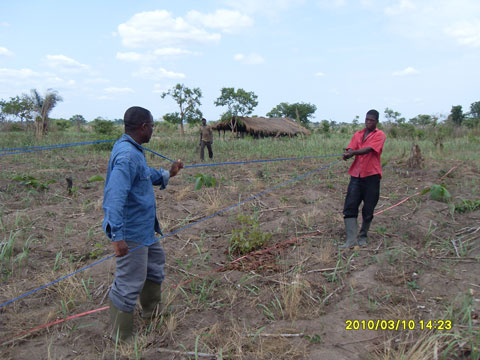 |
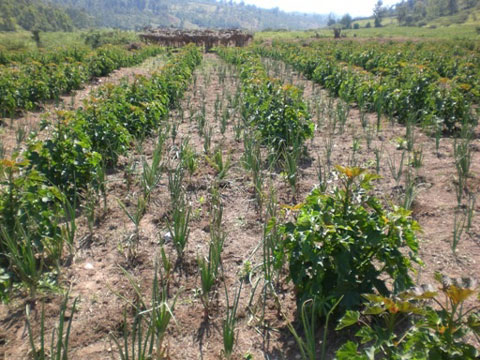 |
|
GuKam prepares the intercropping of Jatropha & Maize on its Pilot Plantation in Avégamé – Development of Best Agronomic Practices for the TOMOKA Project |
Intercropping Jatropha & vegetables (in Nicaragua) - will be tested by GuKam with a view to TOMOKA’s women orientated programs - |
|
 Français
Français